Physical Address
304 North Cardinal St.
Dorchester Center, MA 02124
Physical Address
304 North Cardinal St.
Dorchester Center, MA 02124
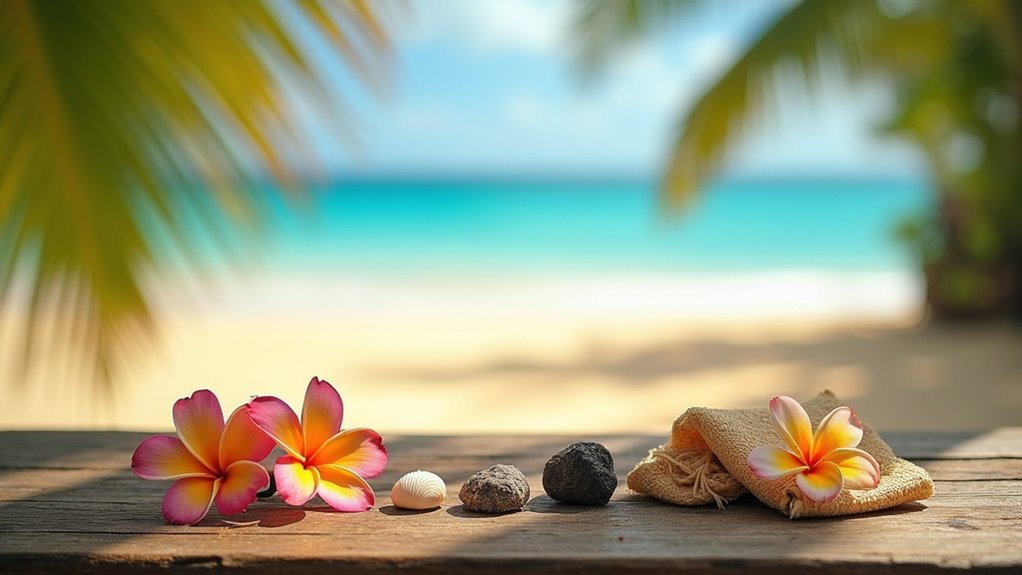
Discover Hawaii's 50 essential words that transform tourists into welcomed guests while honoring the islands' rich cultural heritage.
Learning basic Hawaiian phrases enriches your island experience. Start with “aloha” (hello/goodbye) and “mahalo” (thank you), which carry deeper cultural meanings than simple greetings. “Ohana” represents family and community bonds, while “e komo mai” welcomes visitors graciously. These words reflect Hawaii’s unique value system developed in isolation, emphasizing love, respect, and interconnectedness. Mastering these expressions shows respect for local culture and opens doors to authentic connections with islanders.
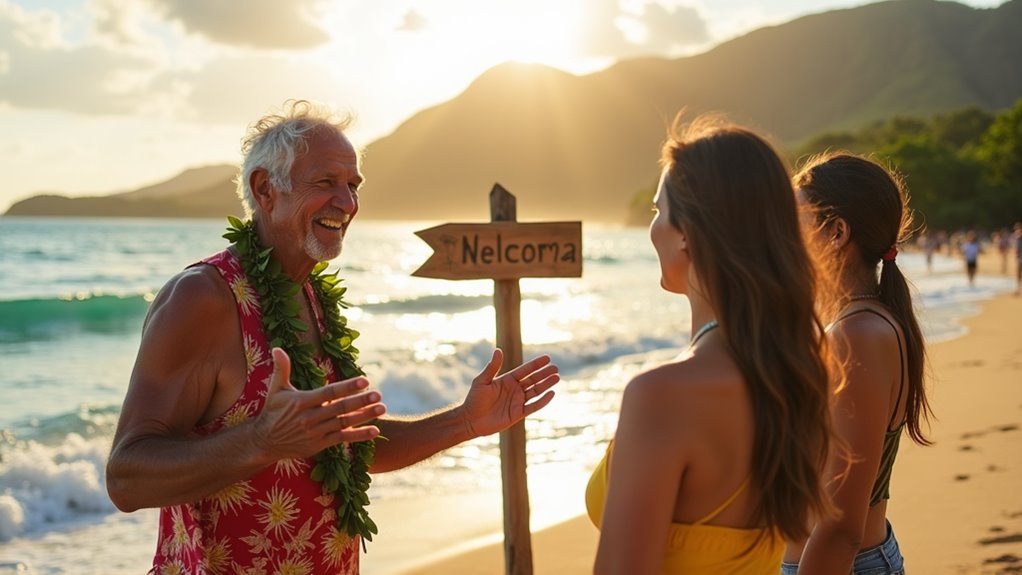
The opulence of Hawaiian culture reveals itself in the word “aloha,” which goes far beyond a simple greeting. Composed of “alo” (share) and “ha” (breath of life), this term embodies a profound philosophy central to Hawaiian identity.
When you’re in Hawaii, you’ll hear aloha used as both hello and goodbye, but it’s much more. As a noun, it expresses love, compassion, and empathy; as a verb, it means to love and show kindness. Phrases like “Aloha kakahiaka” (good morning) and “Aloha kākou” (greetings to everyone) demonstrate its versatility. This concept represents a Hawaiian value system that was developed in complete isolation for over 1500 years after Polynesians first arrived to the islands. The aloha spirit infuses daily life in Hawaii, from casual interactions to special occasions and even snorkeling experiences on beautiful islands like Lanai.
The authentic “aloha spirit” is legally recognized in Hawaiian governance and encourages speaking from the heart, listening genuinely, and sharing life energy with others you encounter.
A cornerstone of Hawaiian communication, “mahalo” serves as more than just a simple “thank you.” When you’re visiting the islands, you’ll quickly notice this word’s prevalence in daily interactions.
Rooted in the Proto-Polynesian word “masalo,” mahalo encompasses admiration, praise, respect, and esteem.
Mahalo carries centuries of cultural wisdom, expressing not just gratitude but a profound acknowledgment of another’s inherent worth.
For deeper appreciation, use “mahalo nui loa,” meaning “thank you very much.”
Using mahalo demonstrates respect for Hawaiian culture and helps foster connections with locals. It’s not merely polite—it embodies the Hawaiian worldview of interconnectedness and mutual respect. Learning essential Hawaiian phrases will enrich your experience while visiting the beautiful islands. When someone thanks you with mahalo, responding with “aole pilikia” shows your understanding of the reciprocal nature of Hawaiian gratitude.
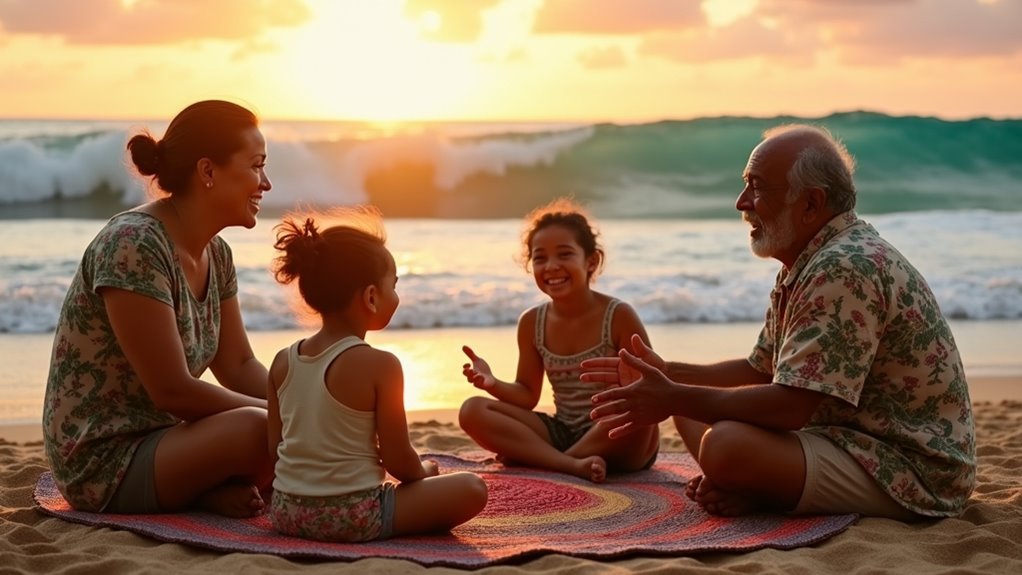
Beyond simple translation, “ohana” represents one of Hawaii’s most profound cultural concepts that you’ll encounter throughout the islands. This term extends far beyond immediate family to include extended relatives, close friends, and community members who support each other.
When you hear Hawaiians speak of “ohana,” they’re referring to a social structure built on mutual care and responsibility. It’s a living practice of the aloha spirit that shapes daily life in Hawaii. The concept of ohana is central to how successive generations develop their worldview and values through family relationships. Hawaii’s smaller islands like Lanai’s attractions showcase how tight-knit communities maintain these traditional family bonds despite modern influences.
Understanding ohana provides insight into why Hawaiians value community connections and collective support so highly.
E komo mai embodies the spirit of Hawaiian hospitality, reflecting the deep cultural value of inclusiveness. You’ll encounter it at hotels, restaurants, shops, and community events throughout the islands. Another similar expression you might hear is “E Kipa Mai”, which also welcomes visitors but with a slightly more casual invitation to come and visit.
Learning to say this phrase shows respect for Hawaiian culture and helps you connect with locals. Try combining it with other basic phrases like “aloha” (hello/love) and “mahalo” (thank you) to enhance your cultural experience. When visiting Oahu’s attractions, you’ll have many opportunities to practice these phrases with friendly locals.
The phrase represents more than just words—it’s an invitation to participate in Hawaii’s traditions and become part of the community during your stay.
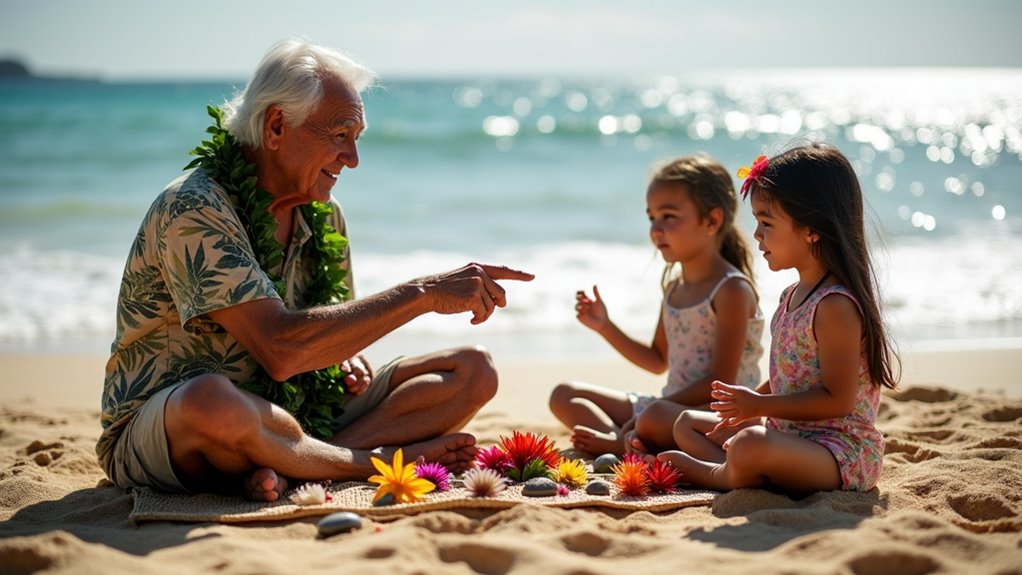
In Hawaiian culture, “keiki” (pronounced “kay-kee”) represents much more than simply “children.” This versatile word encompasses offspring, descendants, youngsters, and even extends metaphorically to young animals and plant shoots.
You’ll hear this term used frequently in daily life, as keiki hold a central position in Hawaiian social structures and family life. The spiritual dimension is reflected in phrases like “Ua keiki kākou no ke Akua,” meaning “we are children of God.”
When you visit Hawaii, you’ll notice how keiki are nurtured with aloha and taught respect for both land and ancestors from an early age:
Many young surf enthusiasts in Hawaii begin learning water skills early, contributing to the islands’ reputation as a premier surf destination.
Hawaiians frequently express farewells with “a hui hou,” a phrase that carries much deeper meaning than a simple goodbye. Pronounced “ah hoo-ee hoh,” this phrase translates to “until we meet again,” conveying hope for future reunions rather than permanent separation.
You’ll hear “a hui hou” at both casual gatherings and formal events. When addressing a group, you can use “a hui hou kākou” meaning “until we all meet again.” The phrase reflects core Hawaiian values of connection, community, and respect for relationships. Like the friendly locals in Canada, Hawaiians place high importance on hospitality and warm interpersonal exchanges.
When practicing this phrase, focus on smooth syllable progressions and proper intonation. Using it correctly shows cultural appreciation whether you’re a traveler departing the islands or simply ending a coffee meetup with local friends. In traditional Hawaiian culture, saying a direct “goodbye” is sometimes considered impolite or superstitious, as it suggests a permanent farewell rather than an anticipated reunion.
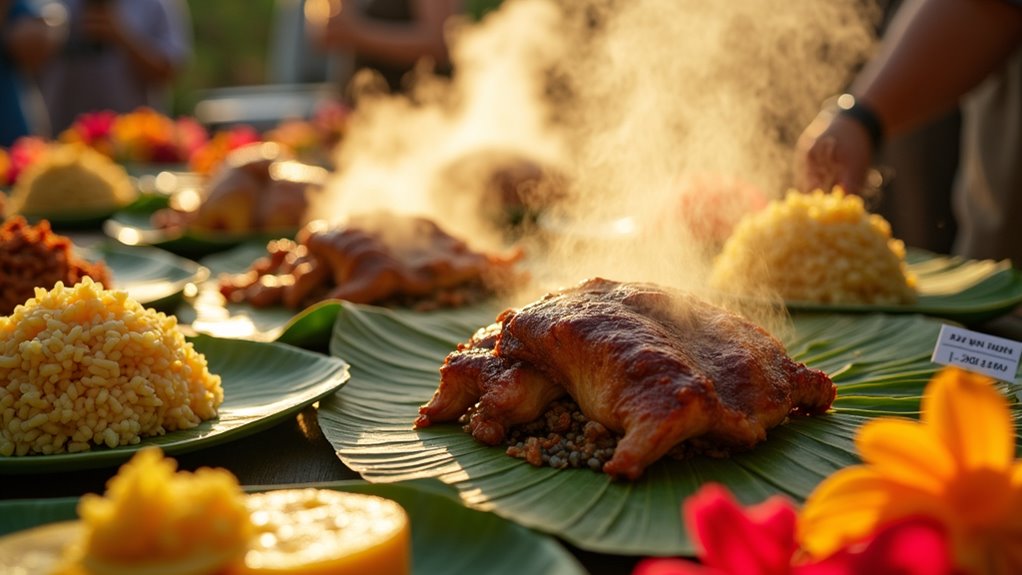
Now that you can say goodbye properly, let’s explore how to express your appreciation for Hawaii’s incredible food. When tasting something delicious in Hawaii, simply say “ʻOno!” (pronounced “OH-no”). This versatile word perfectly captures that moment when kalua pig melts in your mouth or when fresh poke satisfies your seafood craving.
To expand your food vocabulary, remember these phrases:
Hawaiian cuisine reflects the islands’ opulent cultural fusion, blending Polynesian traditions with Japanese, Chinese, and Portuguese influences. The traditional cooking method of using imu earth ovens for kālua cooking remains an important cultural tradition today. Many visitors enjoy sampling these authentic Hawaiian dishes while watching the spectacular sunrise over Maui’s beautiful landscapes.
You’ll find these phrases essential when steering through Hawaii’s diverse food scene.
When traversing the Hawaiian Islands, you’ll quickly discover two essential directional terms that locals use every day: “makai” and “mauka.” These words replace the typical north, south, east, and west directions you might be familiar with.
“Makai” (muh-kahy) means “toward the ocean” or “oceanside,” while “mauka” (mao-kah) means “toward the mountains” or “mountainside.”
Rather than saying “turn right” or “left,” locals might instruct you to “go mauka on Kamehameha Highway.”
These terms stem from the traditional Hawaiian land division system called ahupua’a, which divided land from mountains to sea.
Understanding these directional terms will enhance your travel safety while exploring the islands.
Two other important directional terms are “ewa” and “waikiki,” which indicate northwesterly and southeasterly directions respectively.
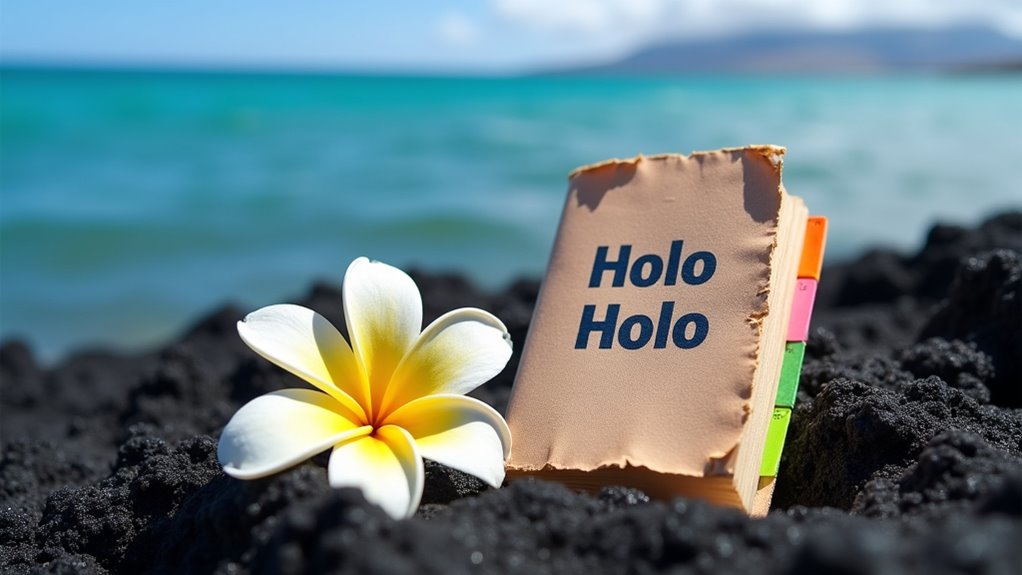
Among Hawaii’s most cherished cultural concepts, “Holo Holo” captures the essence of spontaneous exploration that defines island life. Pronounced “hoh-LO-hoh-LO,” this term describes wandering without a specific destination—simply exploring for the joy of discovery. It reflects a carefree attitude toward travel while emphasizing the journey over the destination.
When you embrace the spirit of Holo Holo, you’re connecting with Hawaiian cultural practices that value:
More than just physical wandering, Holo Holo represents a philosophical approach to life. This cultural expression is often used to describe leisure or recreational activities, perfectly embodying the Hawaiian appreciation for exploration.
You’ll often hear locals describe outings as “going Holo Holo”—whether they’re hiking mountain trails, cruising coastal roads, or sailing between islands. This approach to exploration can be especially rewarding when planning a 7-day itinerary for experiencing the authentic beauty of the Hawaiian islands.
At the heart of Hawaiian culture lies kōkua, a profound value that embodies selfless assistance and communal support. When you offer kōkua, you’re giving help without expecting anything in return, strengthening the bonds that hold communities together. This concept can be seen throughout Hawaiian society, as signage with “kokua” appears in marketplaces and on street signs, serving as daily reminders of this cultural value.
You’ll hear kōkua used as both a noun and verb in everyday Hawaiian life. Parents teach this concept from childhood, emphasizing its role alongside the aloha spirit in creating harmony and respect among people. When visiting the Garden Island of Kauai, you’ll witness the practice of kōkua through the warm hospitality and genuine helpfulness of locals.
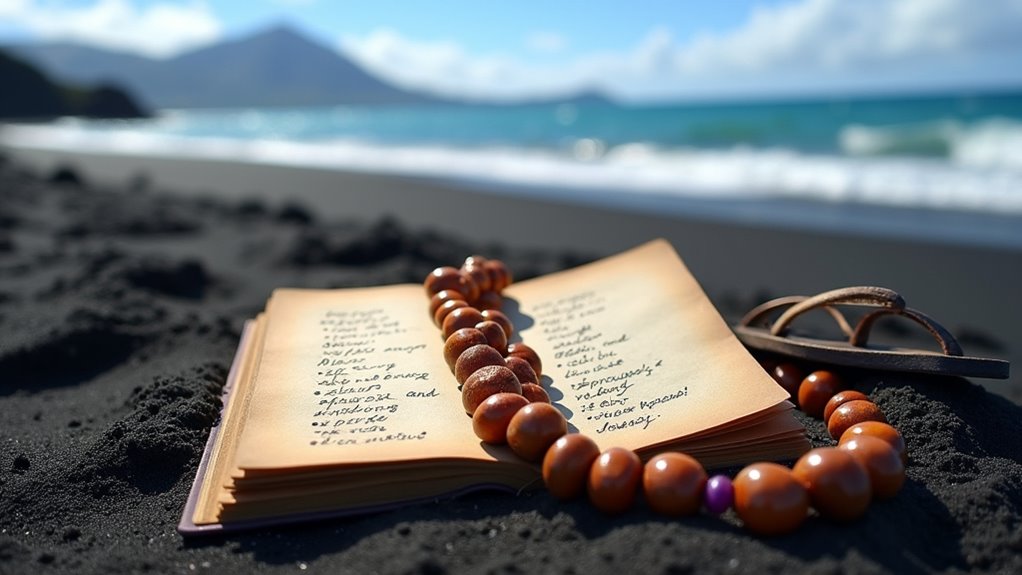
What exactly makes someone truly local in Hawaii? The term kamaʻāina, literally “child of the land,” refers to both native-born residents and those who’ve lived in Hawaii long enough to develop deep connections.
Beyond just residency, being kamaʻāina means embracing Hawaiian values and actively participating in community life. The term represents a living philosophy that emphasizes stewardship of and harmony with the environment.
Becoming truly local requires embracing the spirit of aloha through meaningful community connections and cultural respect.
The concept gained renewed importance during the Hawaiian Renaissance of the 1970s when traditional practices were revitalized.
Today, as you navigate life in Hawaii, understanding the kamaʻāina perspective helps bridge the gap between being a visitor and becoming truly local.
While understanding the kamaʻāina perspective is important, you’ll also need to grasp the everyday language locals use. “Howzit” serves as perhaps the most recognizable greeting in Hawaiian Pidgin, functioning as both a casual hello and a quick way to ask how someone’s doing.
When greeted with “howzit,” simply respond with “good” or “all good” to fit right in. You’ll hear variations like “Ho howzit, brah?” or “Howzit, cuz?” in everyday conversations throughout the islands. This familiar greeting phrase is typically used to initiate conversation or check on someone’s well-being.
Using this phrase demonstrates respect for local culture and helps bridge the gap between visitors and residents. The term embodies Hawaiian hospitality and the aloha spirit.
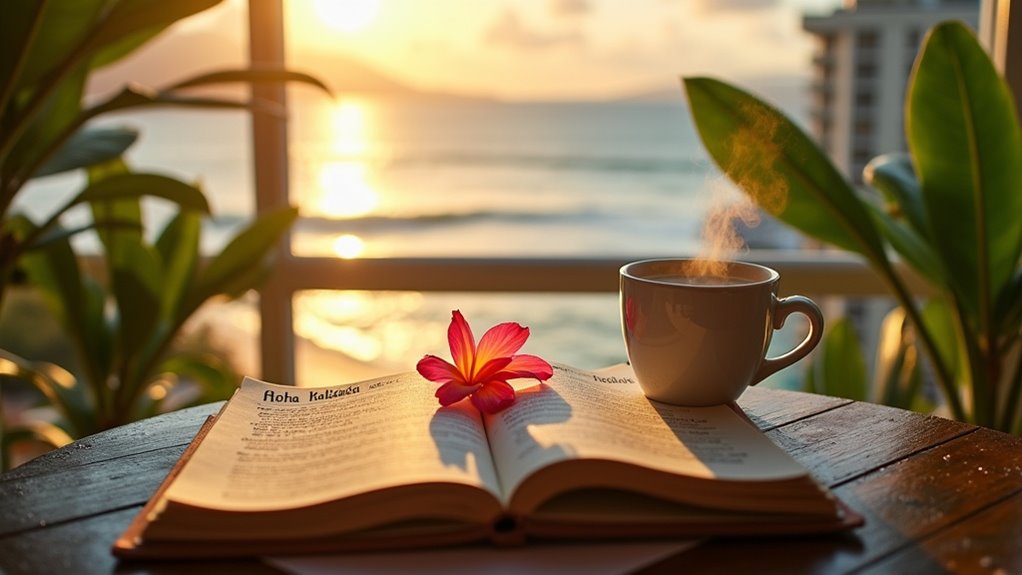
When you’re ready to greet the Hawaiian morning, “Aloha kakahiaka” (pronounced ah-LOH-ha kah-kah-hee-AH-kah) is your perfect phrase. This traditional greeting, meaning “good morning,” is typically used between 6:00 a.m. and 10:00 a.m. throughout Hawaii.
Learning this phrase connects you with Hawaiian culture and shows respect for local traditions. Though introduced after European contact, it’s now an integral part of Hawaii’s cultural identity. For a more intimate greeting, you might experience the traditional honi gesture, where people gently press noses in greeting to share breath and establish connection.
Mastering these time-specific greetings will enhance your interactions with locals and fellow travelers, making your Hawaiian experience more authentic and meaningful.
If you’ve just been thanked with a heartfelt “Mahalo” in Hawaii, responding with “‘A’ole pilikia” (pronounced “ah-oh-leh pee-lee-kee-yah”) is the perfect way to say “you’re welcome” or “no problem.”
This common Hawaiian phrase embodies the islands’ spirit of hospitality and graciousness. Using this phrase regularly helps strengthen social bonds and demonstrates your appreciation for Hawaiian culture.
When you use ‘A’ole pilikia, you’re participating in a cultural tradition that values community respect and courtesy.
The phrase can be spelled with or without the okina (‘) before the A.
Similar expressions include “he mea iki” (no big deal), but ‘A’ole pilikia remains the most widely recognized response to gratitude.
Learning this phrase enhances your culture while visiting Hawaii.
You’ll find it works in both casual conversations and more formal settings, making it a versatile addition to your Hawaiian vocabulary.
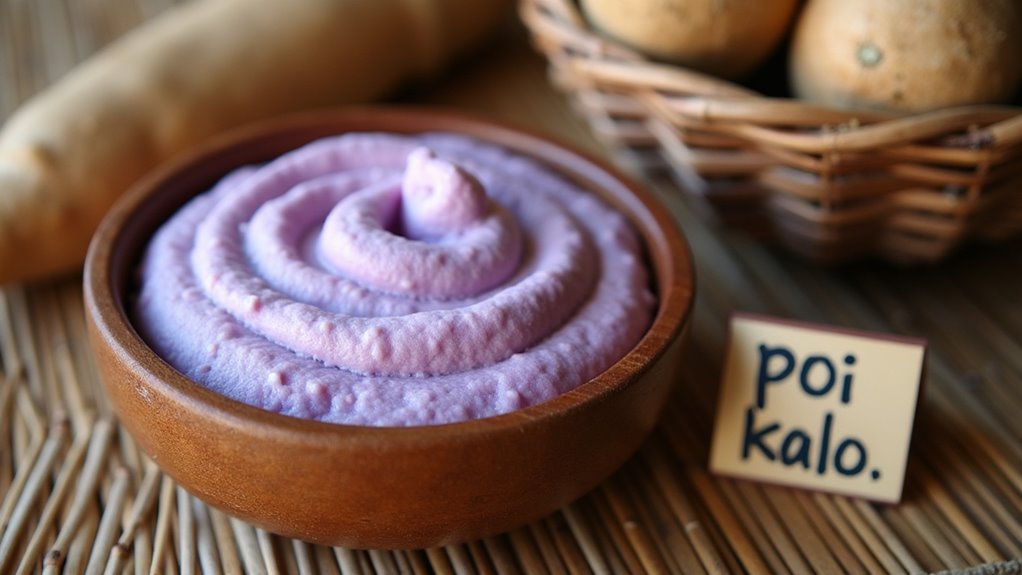
Beyond learning to say “‘A’ole pilikia,” experiencing Hawaiian culture means exploring its unique cuisine. Poi, Hawaii’s sacred staple food, is made from mashed taro root mixed with water. Dating back to 450 AD, this purple paste connects Hawaiians to their ancestors and land.
When you encounter poi, you’ll notice it comes in different consistencies:
Fresh poi tastes slightly sweet, becoming sourer as it ferments. Traditionally, family conflicts ceased when poi was served, showing its cultural significance beyond mere nutrition. According to Hawaiian origin stories, poi comes from the kalo plant that grew from Haloa, the stillborn first child of Wakea and Papa.
It’s often served at luaus alongside fish and other traditional dishes.
As you explore Hawaiian cuisine beyond poi, you’ll inevitably encounter poke, a dish that’s both traditional and trendy. First things first: it’s pronounced “poh-kay” (rhymes with “okay”), not “pokey” or “pokie.”
This Hawaiian word means “to cut crosswise into pieces,” referring to the cubed raw fish that’s the star of the dish. Poke has been recognized as a main dish in Native Hawaiian cuisine for generations.
When ordering a poke bowl, you’ll typically select a base (often rice or greens), protein (traditionally ahi tuna, though salmon and yellowtail are popular too), and toppings like seaweed, sesame seeds, and avocado.
Many places offer signature sauces ranging from traditional soy-based to spicy mayo.
Rich in protein and omega-3s, poke makes for a nutritious meal that’s simple enough to prepare at home with fresh ingredients.
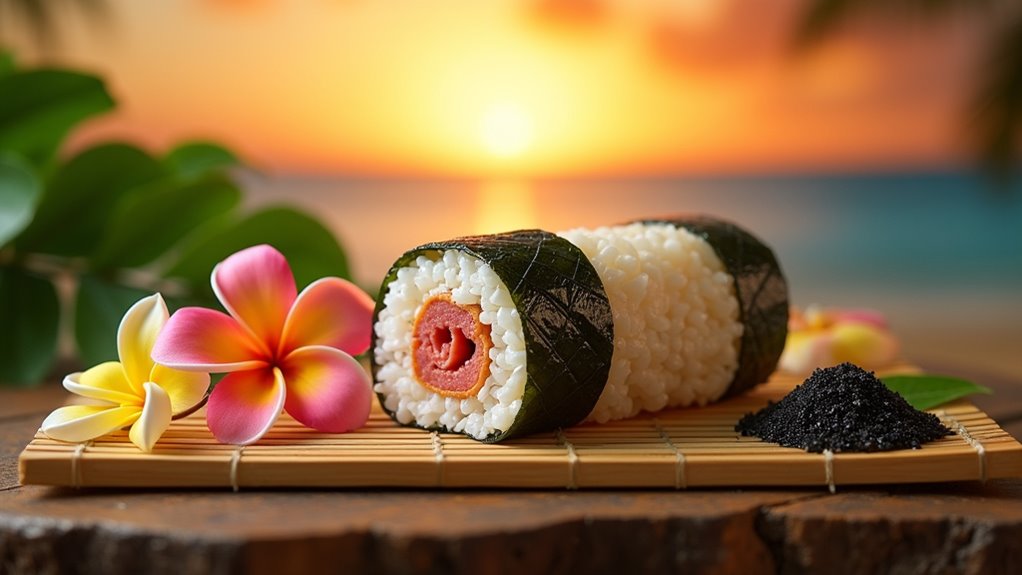
While poke bowls highlight Hawaii’s love for fresh seafood, Spam musubi reveals another fascinating culinary chapter in the islands’ history. This portable snack emerged around 1945, blending Japanese onigiri traditions with American-imported Spam, which gained popularity during WWII when it was served to GIs stationed in Hawaii.
The classic preparation is simple yet satisfying:
You’ll find this affordable, fusion snack everywhere from convenience stores to family gatherings, representing Hawaii’s unique ability to blend different cultural influences into something distinctly local. Today, locals and travelers alike can enjoy authentic versions at renowned establishments like Musubi Cafe Iyasume in Waikiki, where traditional and creative variations continue to honor this beloved snack.
The Hawaiian green sea turtle, known locally as honu, represents far more than just another marine species in Hawaiian culture. These gentle creatures embody strength, longevity, wisdom, and protection in traditional Hawaiian beliefs.
Honu are revered as ‘aumākua (family guardian spirits), serving as spiritual protectors that connect Hawaiians to their ancestors and the natural world. In mythology, they were created by the hero Aiai, symbolizing the deep connection between land and sea. Ancient Hawaiians valued these creatures for their various utilitarian purposes, using their shells as currency, ceremonial necklaces, and food sources.
These turtles play critical ecological roles in maintaining healthy seagrass beds and coral reefs.
Weighing up to 500 pounds, they’re Hawaii’s only native reptile species.
You’ll see honu imagery throughout Hawaiian art, jewelry, and tattoos—powerful symbols of Hawaii’s cultural heritage and ongoing conservation efforts to protect these sacred creatures.
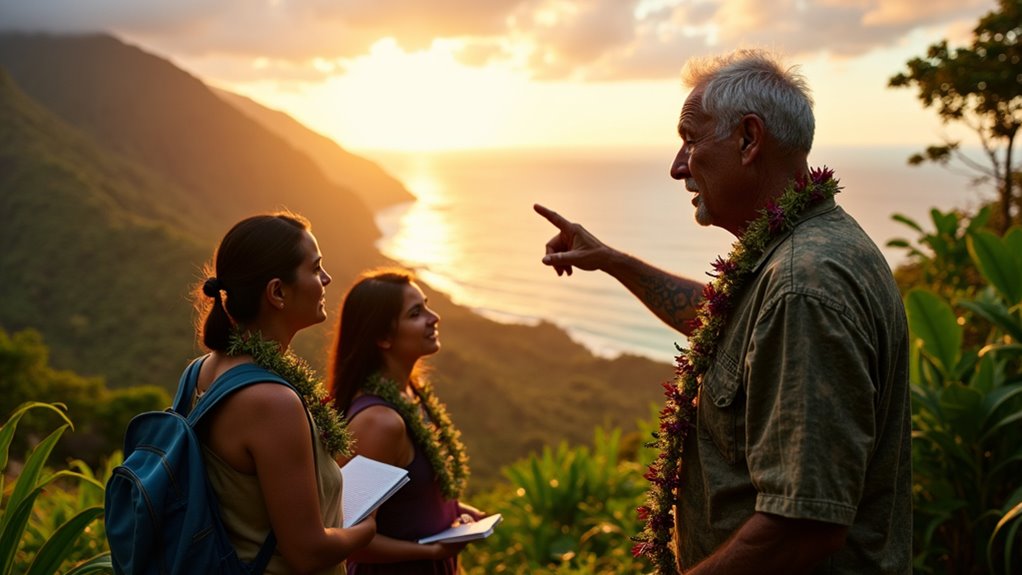
Land in Hawaii represents far more than just physical territory—it’s the spiritual foundation of Hawaiian culture itself. The Hawaiian term ‘āina (pronounced ah-ee-nah) literally connects to the word ‘ai meaning “to eat,” symbolizing how the land nourishes both body and spirit.
In Hawaiian wisdom, ‘āina isn’t merely soil and space—it’s the sacred foundation that sustains all aspects of island life.
When you visit Hawaii, understanding this deep relationship with the land helps you appreciate local customs and values. The concept of mālama ‘āina (caring for the land) guides traditional and modern conservation efforts throughout the islands. This principle represents the duty and privilege of ensuring sustainability for future generations.
Just as ʻāina connects Hawaiians to the land, “kai” (ocean) forms the other half of Hawaii’s natural identity. This fundamental word permeates daily life, culture, and even directions throughout the islands.
When orienting yourself in Hawaii, you’ll often hear “makai” (toward the sea) and “mauka” (toward the mountains) instead of cardinal directions. These ocean-based references are essential for both locals and visitors.
The importance of kai extends to Hawaiian names like Kailani (heavenly sea) and Kainani (beautiful sea), reflecting the ocean’s spiritual and cultural significance. Hawaiians developed rich descriptions like kai mālie and kai koʻo to distinguish between calm and strong seas. The sea surrounds these islands, providing sustenance, recreation, and cultural identity.
Understanding kai helps you appreciate Hawaii’s deep connection to the ocean, which influences everything from traditional practices to environmental conservation efforts. It’s not just geography—it’s central to Hawaiian worldview.
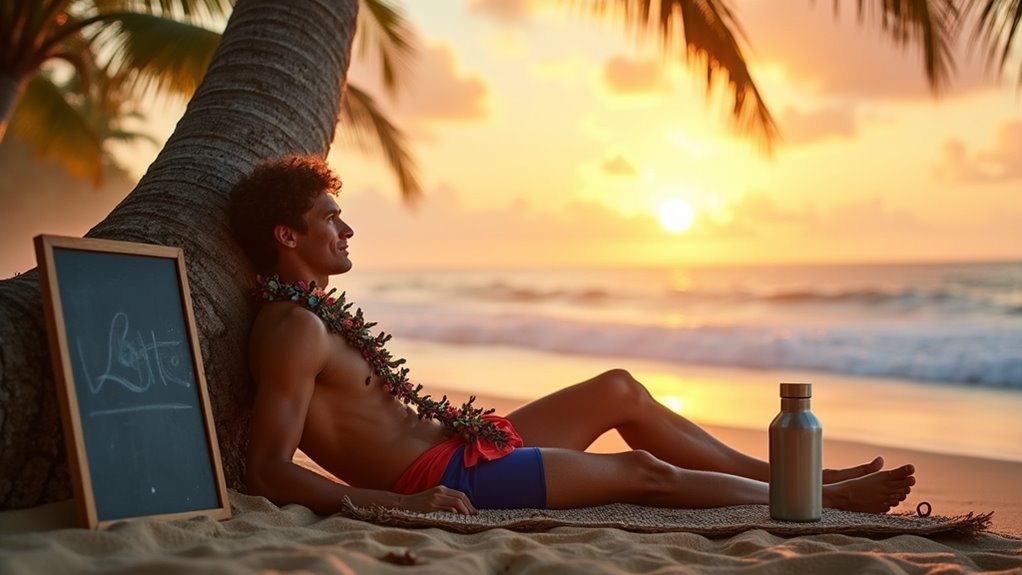
Taking a break might be universal, but in Hawaiian culture, it’s elevated to an art form through the concept of “hoʻomaha” (pronounced ho’oh-mah-hah). This practice goes beyond simply resting—it’s a mindful approach to life that emphasizes balance, wellness, and connection with others.
When you incorporate hoʻomaha into your daily routine, you’re embracing a tradition that values both mental and physical rejuvenation. It’s particularly relevant in today’s fast-paced world, where burnout has become increasingly common.
Learning this term offers insight into Hawaiian values while providing practical wisdom for modern living.
When you hear someone called “braddah” or “sistah” in Hawaii, you’re witnessing more than just casual speech—you’re experiencing the warm, inclusive nature of Hawaiian Pidgin. These terms, pronounced “bra-dah” and “sis-tah,” extend far beyond blood relations to friends and community members.
Embracing someone as “braddah” or “sistah” in Hawaii reflects the islands’ spirit of connection beyond blood ties.
“Braddah” (sometimes shortened to “brah”) signals camaraderie and closeness between men, while “sistah” serves a similar purpose for women. You’ll also hear “auntie” and “uncle” used respectfully for elders, regardless of actual family ties.
These terms emerged during plantation days when diverse ethnic groups created a shared language. The concept connects to “ohana” (oh-ha-nah), the Hawaiian word for family that embraces both biological and chosen relationships.
Using these words appropriately shows you understand the community-centered values of Hawaiian culture.
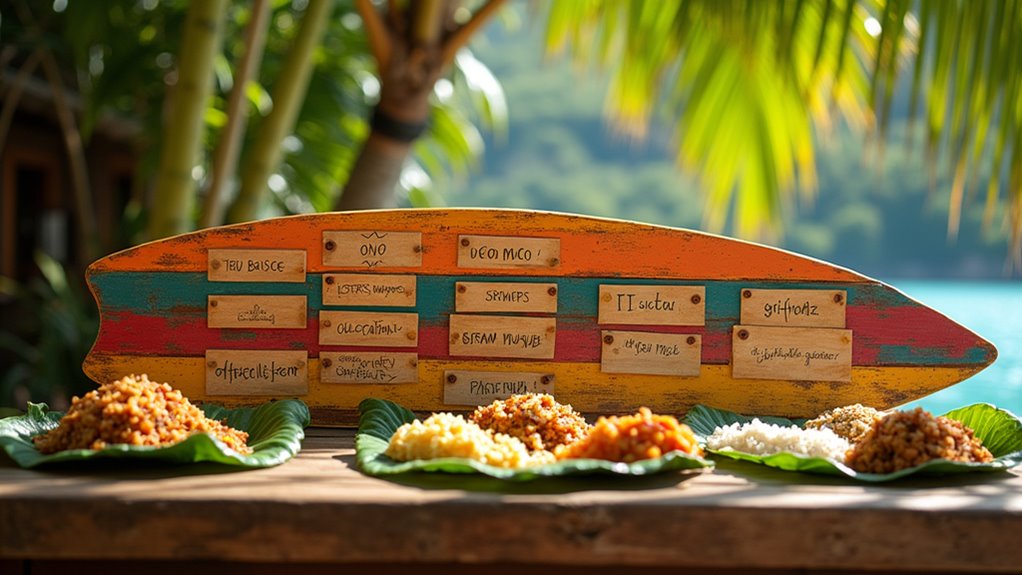
If you’ve spent any time in Hawaii, you’ll quickly learn that food is referred to as “grindz” in local slang. This term is deeply ingrained in Hawaiian pidgin and food culture.
When locals say “Let’s go get some grindz,” they’re inviting you to share a meal—reflecting the communal nature of Hawaiian dining.
Understanding food slang helps you connect with locals and appreciate Hawaii’s diverse cuisine that blends Asian, American, and traditional Hawaiian flavors.
Perhaps the ultimate chameleon of Hawaiian Pidgin English, “da kine” functions as the most versatile phrase you’ll encounter in the islands. Pronounced “duh-KINE,” it literally means “that kind,” but serves as a substitute for virtually any noun, action, or concept.
When someone says “Pass me da kine” while pointing at salt, they’re asking for salt. If you hear “You bring da kine fo’ drink?” they’re asking about beverages.
Context, gestures, and tone provide the necessary clues to understand the intended meaning.
“Da kine” reflects Hawaii’s multicultural heritage and serves as a marker of local identity. You’ll hear it from locals of all ages, making it an essential phrase to recognize during your Hawaiian travels.
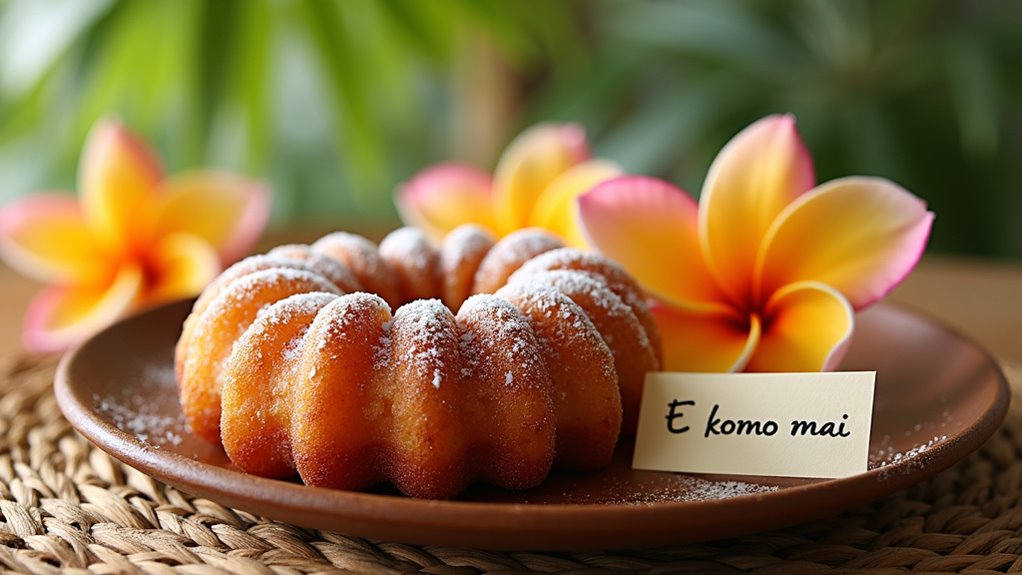
Among Hawaii’s most beloved desserts, malasadas have delighted locals and visitors alike since Portuguese immigrants introduced them in the 1800s. These golden, sugar-dusted pastries originated from workers who brought traditional recipes from the Azores and Madeira Islands. Leonard’s Bakery in Honolulu transformed this ethnic treat into a mainstream sensation in the 1950s.
The Portuguese gift of sugar-dusted malasadas has become a quintessential Hawaiian treat, cherished across the islands since the 19th century.
When you’re in Hawaii, you’ll notice malasadas aren’t just any doughnut:
This Portuguese-Hawaiian fusion dessert perfectly represents the islands’ multicultural heritage.
When visiting Hawaii, you’ll likely encounter the deeply meaningful practice of hoʻokupu, a traditional gift-giving custom that dates back centuries in Hawaiian culture.
This practice embodies Hawaiian values of reciprocity and respect, with offerings historically including fruits, fish, and other products of personal labor. During traditional ceremonies, these gifts were placed on a lele (offering tower) and presented to aliʻi (rulers) through attendants as a sign of deference.
Today, hoʻokupu remains significant during events like the Makahiki festival.
Be aware that some modern interpretations, like leaving rocks as offerings, aren’t authentic and can be disrespectful. Proper hoʻokupu should only be performed by trained individuals like Kahu or Kumu.
As a visitor, it’s important to appreciate this tradition without attempting to replicate it without proper understanding.
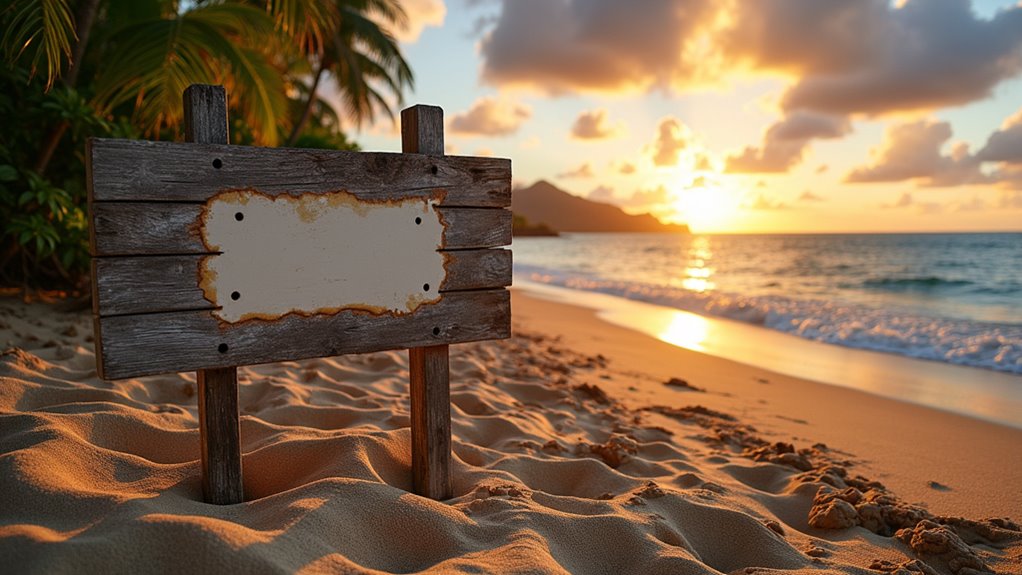
If you’ve ever heard a local Hawaiian describe something as “all hamajang,” you’re getting a glimpse into one of Hawaiian Pidgin‘s most colorful expressions. This versatile term (sometimes spelled “hammajang” or “hemajang”) perfectly captures the essence of something that’s completely messed up, disorganized, or in disarray.
You’ll impress locals by correctly using this term when things go sideways during your Hawaiian vacation.
Added to the Oxford English Dictionary in 2019, “hamajang” represents the unique cultural blend that makes Hawaiian Pidgin so expressive.
The simplest way to sound like a local in Hawaii is learning to use “l’dat” in your everyday conversations. This common Hawaiian Pidgin contraction of “like that” helps you express preferences or agreement effortlessly.
Pronounced “luh-dat,” you’ll hear variations including “liddat” and “ladat” without any difference in meaning. Try using it when describing how you want something: “I like my coffee l’dat” or when agreeing with someone: “Yeah, l’dat is good.”
You’ll find this phrase particularly useful in restaurants, markets, and casual social settings. While it’s not standard English or Hawaiian, using l’dat appropriately shows respect for local linguistic traditions.
Locals appreciate visitors who make an effort to incorporate these phrases, creating a more relaxed and friendly atmosphere.
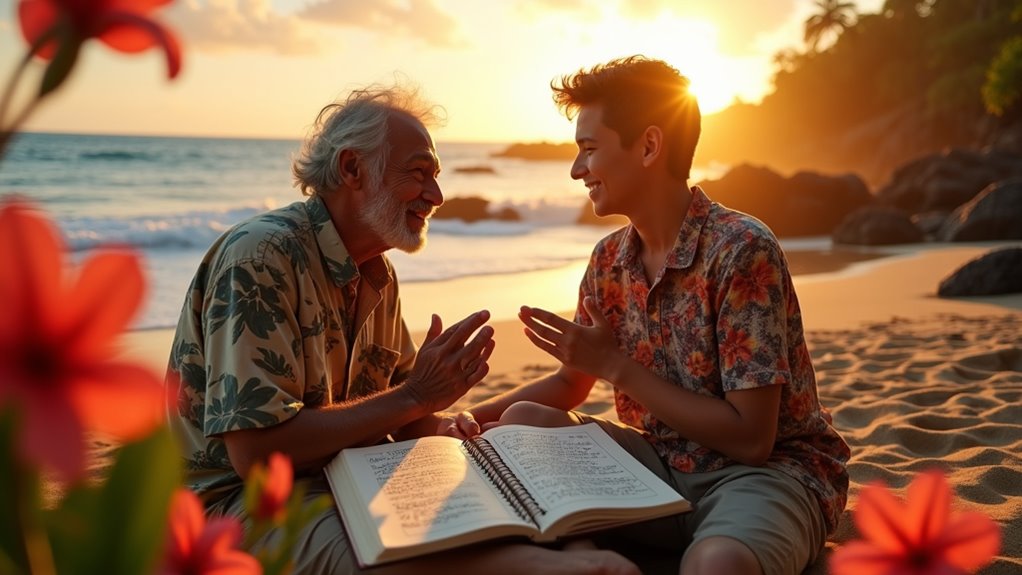
Why settle for a simple “thank you” when you can express heartfelt appreciation in Hawaiian? “Mahalo nui loa” functions as one of Hawaii’s most powerful phrases, literally meaning “thank you very much” but carrying deeper cultural significance than its English equivalent.
You’ll pronounce it as “mah-HAH-loh NOO-ee LOH-ah,” emphasizing the middle syllable of “mahalo.” Use this expression when someone has gone above and beyond or when you feel particularly grateful.
In Hawaiian culture, gratitude isn’t just polite—it strengthens community bonds and reflects traditional values of reciprocity.
Believed to originate with Hamana Kalili, a sugar mill worker who lost three fingers, the shaka has evolved into a universal symbol of friendship, gratitude, and solidarity throughout Hawaii.
Born from loss, the shaka thrives as Hawaii’s enduring gesture of aloha spirit and community connection.
You’ll see locals use it while driving to express thanks or as a casual greeting.
When you flash a shaka in Hawaii, you’re participating in island culture and showing respect for local traditions.
The gesture has gained worldwide recognition, particularly in surf communities, where it represents the laid-back “hang loose” attitude that defines Hawaiian lifestyle.
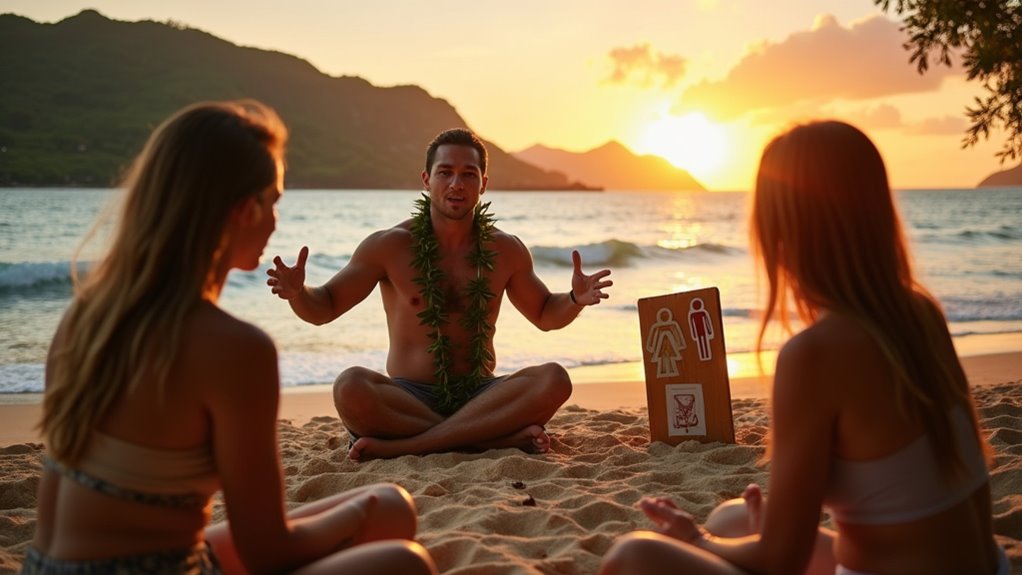
Beyond the physical expressions of Hawaii’s culture lies its prosperous linguistic foundation, where gender terms carry important cultural meanings. When learning Hawaiian, you’ll encounter “wahine” (woman) and “kāne” (man) frequently in everyday conversation.
Unlike Western binary perspectives, traditional Hawaiian culture embraces a more fluid understanding of gender.
Understanding these terms helps you navigate both casual conversations and gain deeper insight into Hawaiian cultural values that honor diversity and inclusion.
When most visitors hear “lanai” in Hawaii, they often think of the outdoor porches or verandas common in Hawaiian homes, but the term actually represents one of Hawaii’s most exclusive and breathtaking islands.
Located between Maui and Molokaʻi, Lanai is Hawaii’s sixth largest island, covering 140.5 square miles. It’s home to about 3,367 residents, with 98% owned by tech billionaire Larry Ellison.
You’ll find no traffic lights here, and many areas require four-wheel drive vehicles.
Once dominated by pineapple plantations, Lanai now thrives on luxury tourism. The island offers some of Hawaii’s most expensive resorts near Mānele Bay, alongside hiking and mountain biking opportunities.
Despite its small size, Lanai maintains a hospital, community health services, and a single school serving all island students.
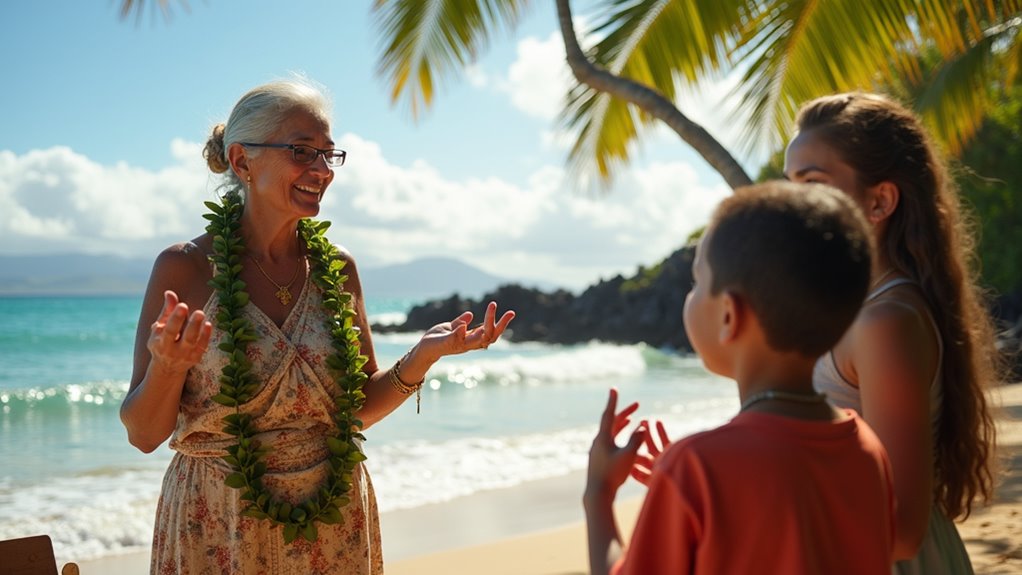
At the heart of Hawaiian culture lies a profound principle that shapes community interactions: “Kokua Aku, Kokua Mai” – help others, be helped. This core value guides daily life in Hawai’i, emphasizing that personal well-being depends on community well-being.
When you offer kokua (help), you’re practicing more than just assistance – you’re participating in the ancient tradition of reciprocity that sustains Hawaiian communities. The full proverb connects this practice to family relationships: “‘Ike aku, ‘ike mai, kokua aku kokua mai; pela iho la ka nohana ‘ohana.”
You’ll find this principle alive today in community service, volunteerism, and cultural preservation throughout the islands.
The simple Hawaiian word “pau” serves as a cornerstone in daily island communication, signifying that something is completely finished or done. You’ll hear locals use it when they’ve completed a meal, finished work, or made a final decision.
Unlike English, where we might say “I’m done,” Hawaiians typically use “pau” in context with the activity. For example, “pau kahana” means “work is finished.” Be careful not to say “I’m pau,” which could imply you’re dead or completely exhausted!
When enjoying pau hana (after-work) activities, you’re celebrating the shift from work to leisure. Listen for this versatile word, sometimes accompanied by a palms-up gesture indicating completion, and you’ll better understand the natural rhythm of island life.
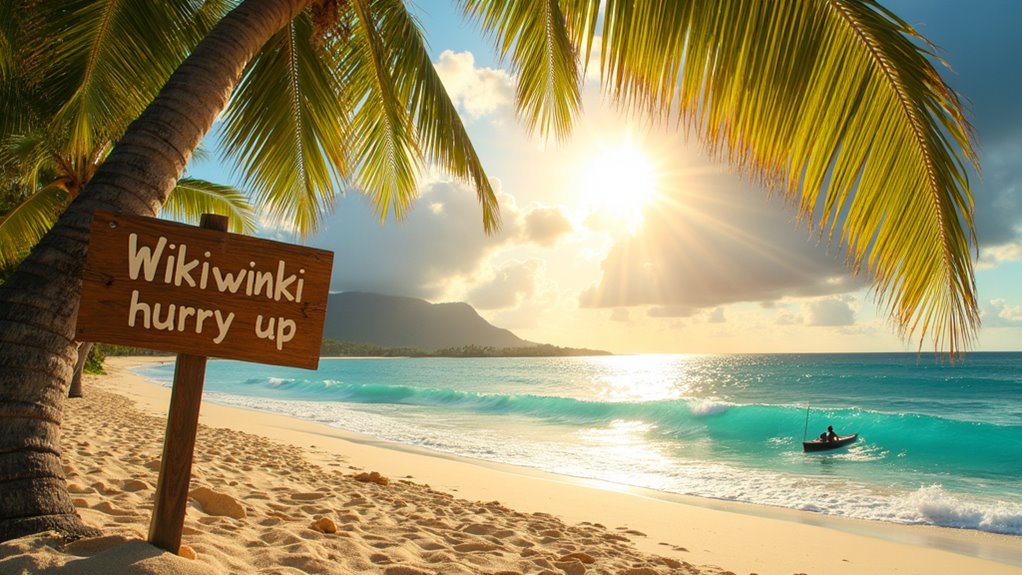
If you’ve ever needed to quicken someone’s pace in Hawaii, “wikiwiki” is your go-to expression. This reduplication of “wiki” (fast) emphasizes urgency in everyday Hawaiian speech. Pronounced as “wee-kee wee-kee,” it’s a direct yet polite way to tell someone to hurry up or do something quickly.
Urgency Hawaiian style: master “wikiwiki” to politely prompt faster action from island locals with authentic flair.
The term gained international recognition when it inspired the naming of the first wiki websites, connecting Hawaiian language to modern digital culture.
Deeply embedded in Hawaiian spiritual tradition, ‘aumakua represent ancestral spirits that serve as family guardians, watching over descendants with protective care. These deified ancestors typically manifest as animals like sharks, owls, or octopuses, but can also appear as plants or natural elements.
‘Aumakua play vital roles in Hawaiian culture—they guide, protect, warn of danger, and communicate through signs in nature. Families honor their ‘aumakua through ritual offerings, ensuring continued protection and guidance. Neglecting these ancestral spirits was believed to invite misfortune.
Today, many Hawaiians still acknowledge their family ‘aumakua, incorporating both traditional and contemporary practices into their relationship with these guardian spirits. When visiting Hawaii, you’ll notice ‘aumakua represented in local art, tattoos, and stories—a symbol of their enduring cultural significance.
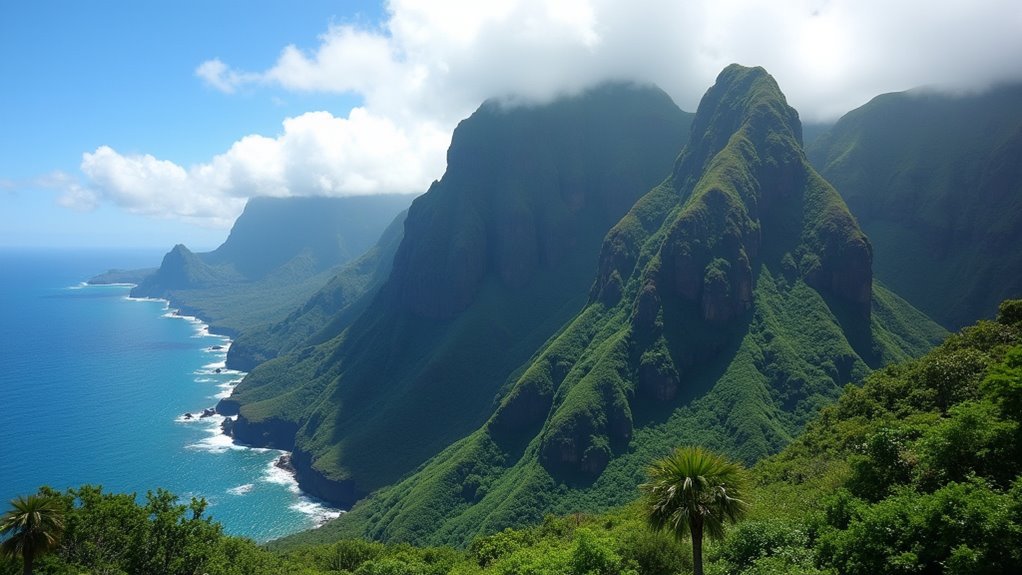
Towering over the Hawaiian landscape, pali—the Hawaiian word for “cliff” or “precipice”—represent some of the islands’ most dramatic geological features. Formed through volcanic activity and shaped by millions of years of erosion, these majestic cliffs tell the story of Hawaii’s geological past.
When you visit Hawaii, you’ll encounter notable pali locations including:
These natural barriers not only divide the islands’ leeward and windward sides but also serve as important cultural landmarks—having been used as travel routes, spiritual sites, and strategic locations for over a millennium.
While the dramatic pali cliffs reveal Hawaii’s geological story, the islands’ cultural narrative unfolds through their most iconic tradition—the lei.
These flower garlands embody the Aloha spirit, symbolizing love, respect, and interconnectedness. When you’re presented with a lei, you’ll experience a custom dating back to ancient Polynesian settlers who first offered garlands to honor their gods.
The lei embraces both giver and receiver in Hawaii’s ancient tradition—a circle of nature’s beauty honoring connections between people and place.
Traditionally, leis were placed above the heart with a respectful bow, though modern greetings often include placement around the neck.
You’ll find leis made from various materials—maile leaves, orchids, pikake blossoms, shells, and even rare bird feathers once reserved for royalty.
Beyond their beauty, leis serve as cultural bridges connecting Hawaiian heritage to the wider world, marking celebrations, ceremonies, and sometimes mourning—each garland telling its own story of Hawaiian identity.
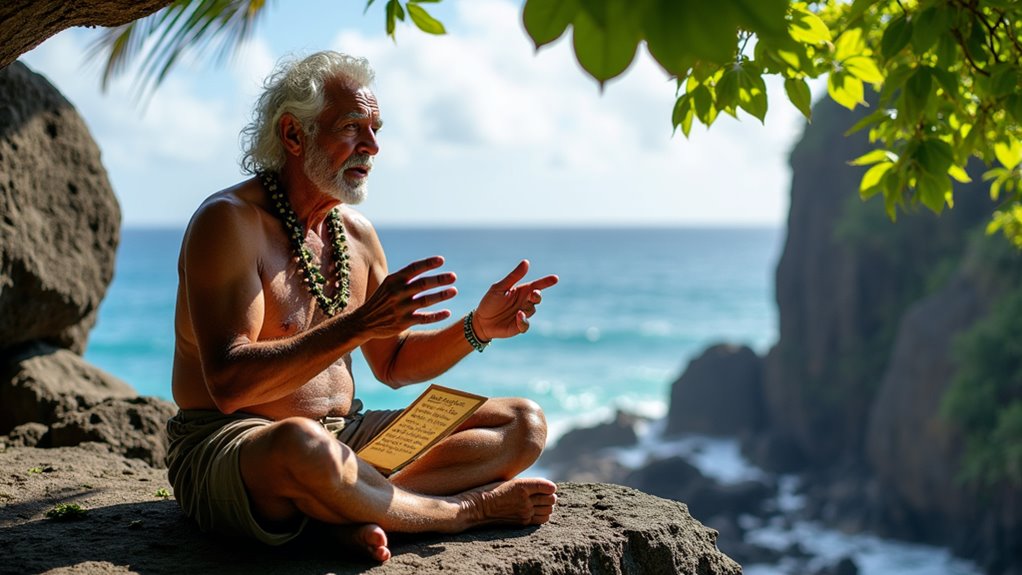
The kahuna tradition forms the backbone of Hawaiian spiritual and professional expertise, stretching back centuries before Western contact. These specialists weren’t simply priests—they were highly trained experts in various disciplines from medicine to navigation.
While you explore Hawaiian culture, you’ll encounter references to different types of kahuna who shaped island society.
Contrary to popular belief, kahuna practices weren’t formally outlawed, though their influence diminished during Western colonization. Today, these traditional knowledge keepers remain crucial to Hawaiian cultural preservation, with many of their practices experiencing revival among those seeking to reconnect with authentic Hawaiian heritage.
When visiting Hawaii, you’ll hear mele at both formal ceremonies and casual kanikapila gatherings where families make music together.
These musical traditions help Hawaiians maintain connections to their heritage while evolving to incorporate contemporary influences—a living bridge between past and present.
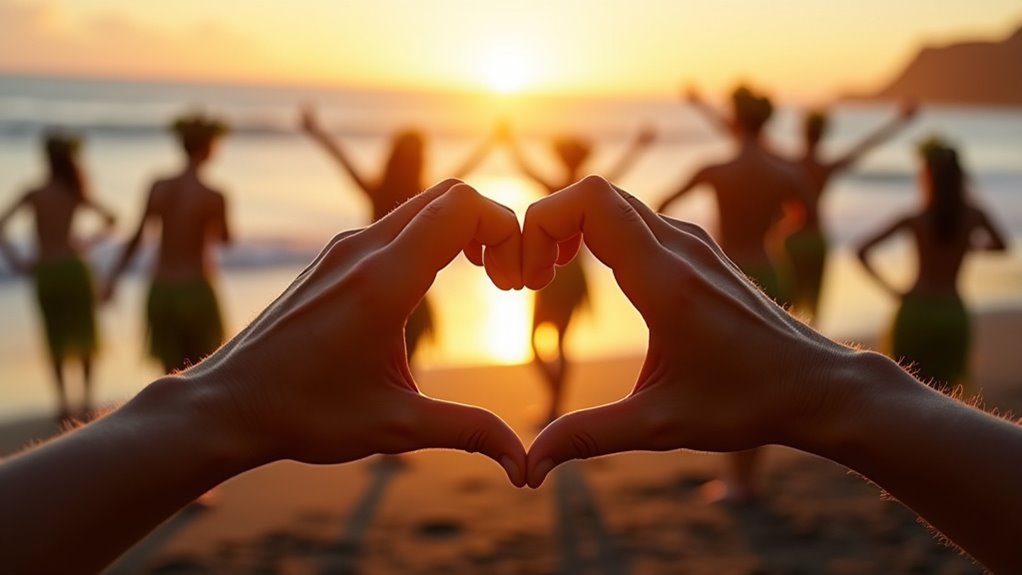
Beyond the musical traditions of Hawaii lies another profound cultural expression: hula. When you witness this ancient practice, you’re experiencing not just a dance but a sacred storytelling tradition that’s nearly as old as the Hawaiian people themselves. Hula serves as a living connection to Hawaiian history, spirituality, and cultural identity.
Understanding Hawaii’s unique geographical relationship requires learning two essential directional terms: mauka and makai. When navigating the islands, you’ll hear mauka (MOW-kah) for directions toward the mountains, while makai (mah-KAI) indicates toward the ocean.
These concepts stem from the ahupua’a system—ancient land divisions that stretched from mountains to sea. Approximately 725 ahupua’a existed across Hawaii, averaging 5,678 acres each and spanning elevations up to 3,100 feet.
This mountain-to-sea connection isn’t just navigational but deeply cultural. Hawaiians recognized the ecological relationship between mauka’s forests, which regulate water flow, and makai’s abundant coastal resources.
When you understand this relationship, you’ll appreciate how the islands’ resources, from mountaintop ‘ōhi’a lehua trees to shoreline fishing grounds, form a connected ecosystem.
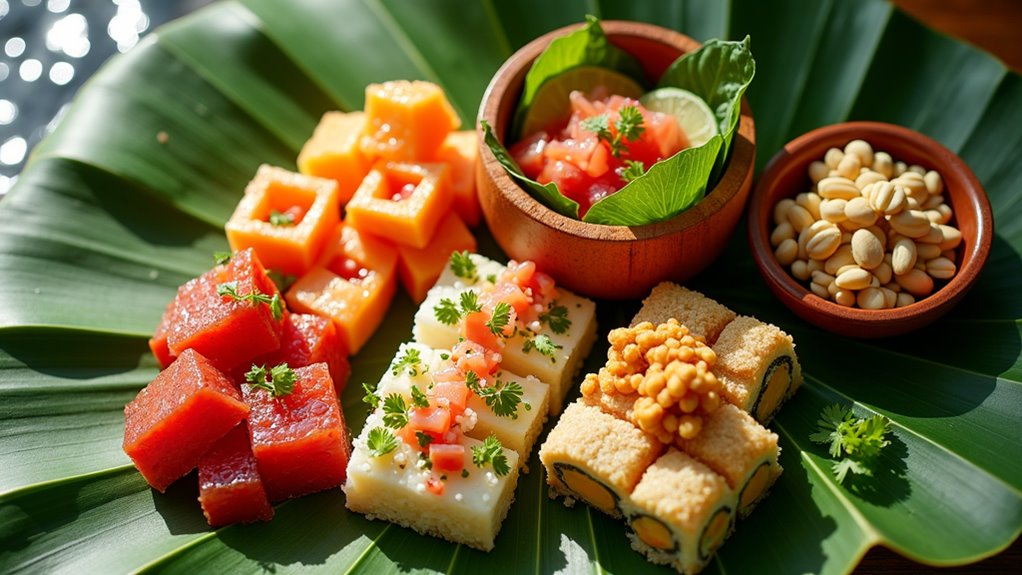
Moving from Hawaii’s environmental connections to its cultural expressions, food brings people together across the islands. When you’re invited to a Hawaiian gathering, you’ll likely encounter “pupu” – small appetizers or finger foods meant for sharing. This term, meaning “small dish” in Hawaiian, encompasses a variety of bite-sized offerings served before meals or at social events.
Food in Hawaii transcends mere sustenance—it’s a communal language spoken through shared pupus that unite diverse island traditions.
When enjoying pupus, you’re participating in a cultural practice that fosters connection and conversation. They’re served at everything from casual beach gatherings to formal luaus, creating a welcoming atmosphere for all guests.
When you visit Hawaii, you’ll quickly discover that conversation takes on a special form known as “Talk Story.” This uniquely Hawaiian tradition goes far beyond casual chitchat—it’s a cultural cornerstone that connects people through the sharing of experiences, memories, and wisdom.
Dating back to before written Hawaiian language existed, talk story remains essential in preserving cultural heritage. You’ll notice it happens naturally when something triggers a memory, leading to impromptu storytelling sessions.
Look for community events where kūpuna (elders) share stories, creating bonds across generations.
If you’re invited to talk story, embrace this opportunity to learn and connect. Many hotels and community gatherings offer formal talk story events, but the best conversations often happen organically among locals.
It’s your chance to experience Hawaiian culture through its oldest tradition.
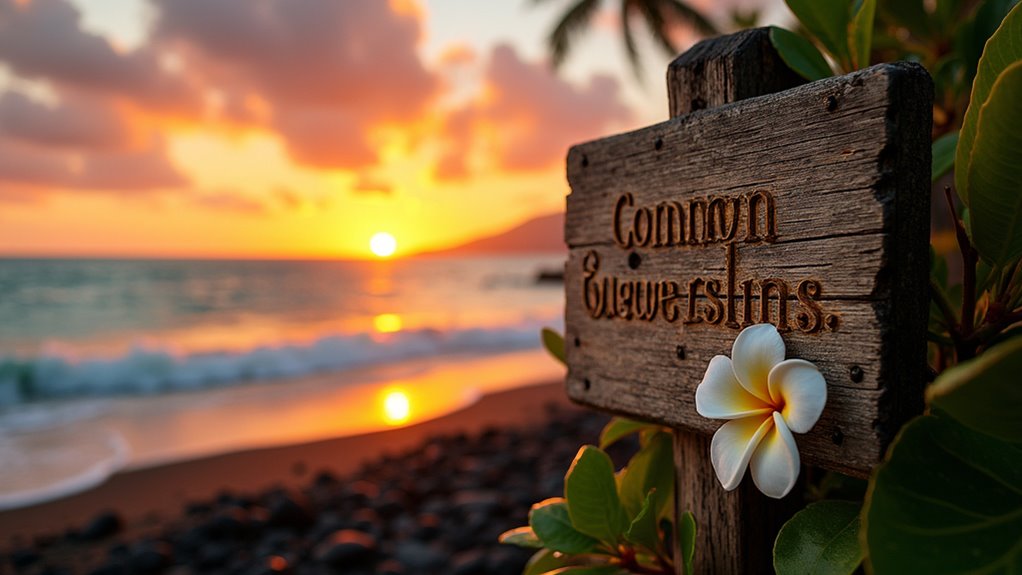
You’ve likely heard the term “haole” during your time in Hawaii, but what exactly does it mean? Originally a Hawaiian word describing outsiders, it now primarily refers to white people or non-locals. The word predates Western contact and has evolved considerably over generations.
The term “haole” has transformed over centuries from describing outsiders to becoming a cultural identifier in Hawaii’s diverse social landscape.
The term’s interpretation depends heavily on context and tone:
While “haole” can carry negative connotations in certain situations, it’s not inherently derogatory. Understanding its nuanced meaning shows respect for Hawaii’s multicultural landscape and helps avoid misinterpretations when you hear it used.
While local terms like “haole” reflect Hawaii’s cultural complexity, the concept of “ohana” sits at the heart of Hawaiian social structure. “Ohana means family, and family means nobody gets left behind or forgotten” – this famous line from Disney’s Lilo & Stitch introduced millions to this Hawaiian term, but its true meaning runs much deeper than a catchy phrase.
In Hawaiian culture, ohana extends beyond blood relatives to include extended family, friends, neighbors, and community members. It’s derived from ‘oha, symbolizing the interconnected growth of the taro plant. The concept embodies mutual obligation, respect for elders, and responsibility toward younger generations.
When you’re part of someone’s ohana, you’re embraced in a system of collective support that shapes social interactions, preserves traditions, and creates a profound sense of belonging and identity.
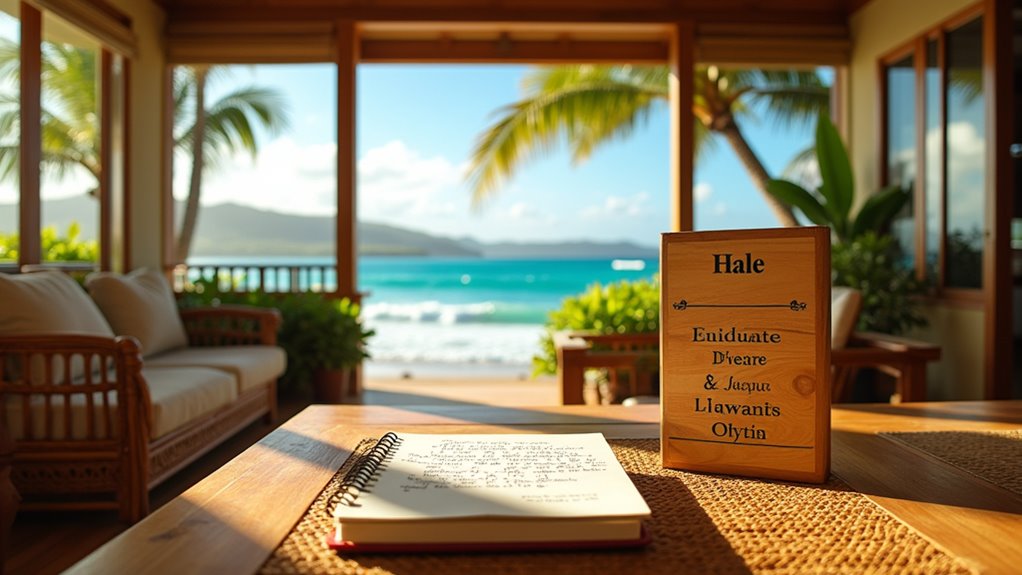
What’s a home without understanding its cultural significance? In Hawaiian, “hale” (pronounced hah-leh) refers to more than just a physical dwelling—it embodies concepts of community, hospitality, and cultural preservation.
Traditionally, different types of hale served specific purposes in Hawaiian society, from the mua (men’s eating house) to the hālau (for canoes or hula instruction).
When you’re visiting Hawaii, understanding the concept of hale helps you appreciate both the architecture you’ll see and the warm welcome you’ll receive.
No Hawaiian experience is complete without attending a lūʻau, the traditional feast that represents the heart of island hospitality. Historically called ʻahaʻaina (“gathering meal”), the modern lūʻau began in 1819 when King Kamehameha II abolished gender and class restrictions that prevented men and women from dining together.
At a lūʻau, you’ll enjoy kālua pig (slow-cooked in an underground imu), poi (pounded taro paste), laulau (meat wrapped in taro leaves), haupia (coconut pudding), and poke (marinated raw fish).
While eating, you’ll experience traditional entertainment including mele (songs), hula dancing, and storytelling.
Today’s lūʻau often blend authentic Hawaiian traditions with multicultural influences, creating a vibrant celebration that brings people together while honoring Hawaiian heritage.
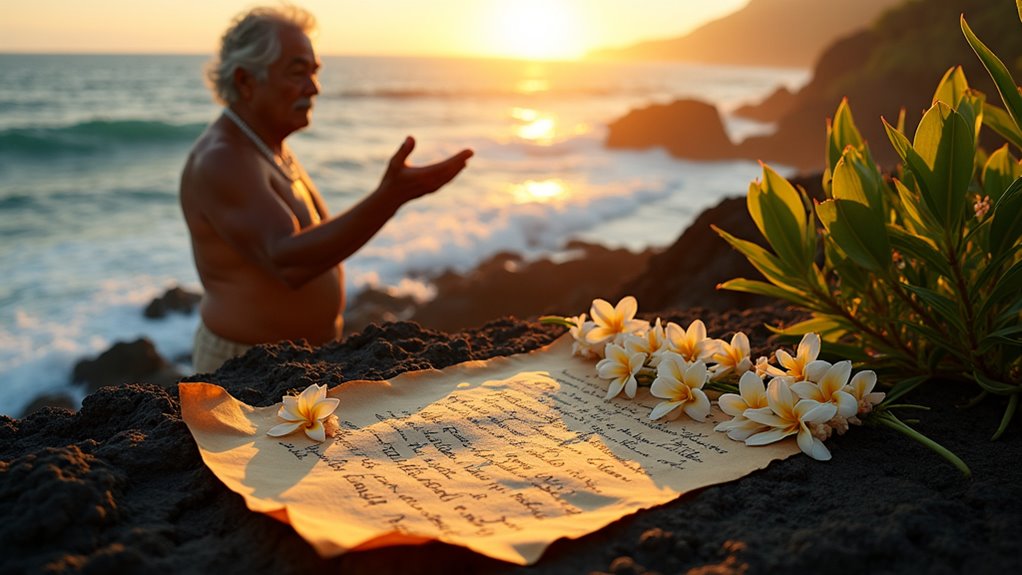
At the core of Hawaiian spiritual beliefs lies the concept of mana, a powerful life force that flows through people, places, and objects. This spiritual energy exists in both inherited and acquired forms, with the aliʻi (ruling class) traditionally possessing greater mana through their divine lineage.
Mana flows through all creation, with aliʻi inheriting the most powerful spiritual energy through divine ancestry.
You’ll find that mana influences every aspect of Hawaiian culture:
Understanding mana helps you appreciate why Hawaiians treat certain locations with reverence and why genealogies (moʻokūʻauhau) remain so important in connecting present-day Hawaiians to their ancestral power.
The concept of Aloha Spirit runs far deeper than the familiar greeting exchanged between travelers and locals on Hawaiian shores. It’s actually a legally recognized philosophy in Hawaii since 1986, guiding official conduct and social interactions.
Aloha embodies five essential values: ʻAkahai (kindness), Lōkahi (unity), ʻOluʻolu (agreeableness), Haʻahaʻa (humility), and Ahonui (patience). When you practice these principles, you’re not just being polite—you’re participating in a profound energy exchange that balances relationships and communities.
The term literally means “the presence of divine breath,” combining “Alo” (face) and “Ha” (breath).
As you wrap up your Hawaiian language journey, remember that these 50 phrases are just the beginning. You’ll find that a little effort goes a long way when connecting with locals and their culture. As Hawaiians say, “A’ohe pau ka ‘ike i ka hālau ho’okahi” (All knowledge is not taught in one school). Keep practicing, stay curious, and let the Aloha spirit guide your adventures in the islands.